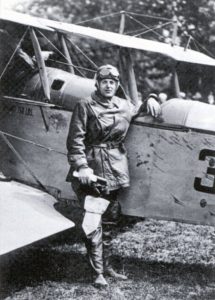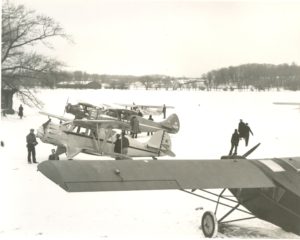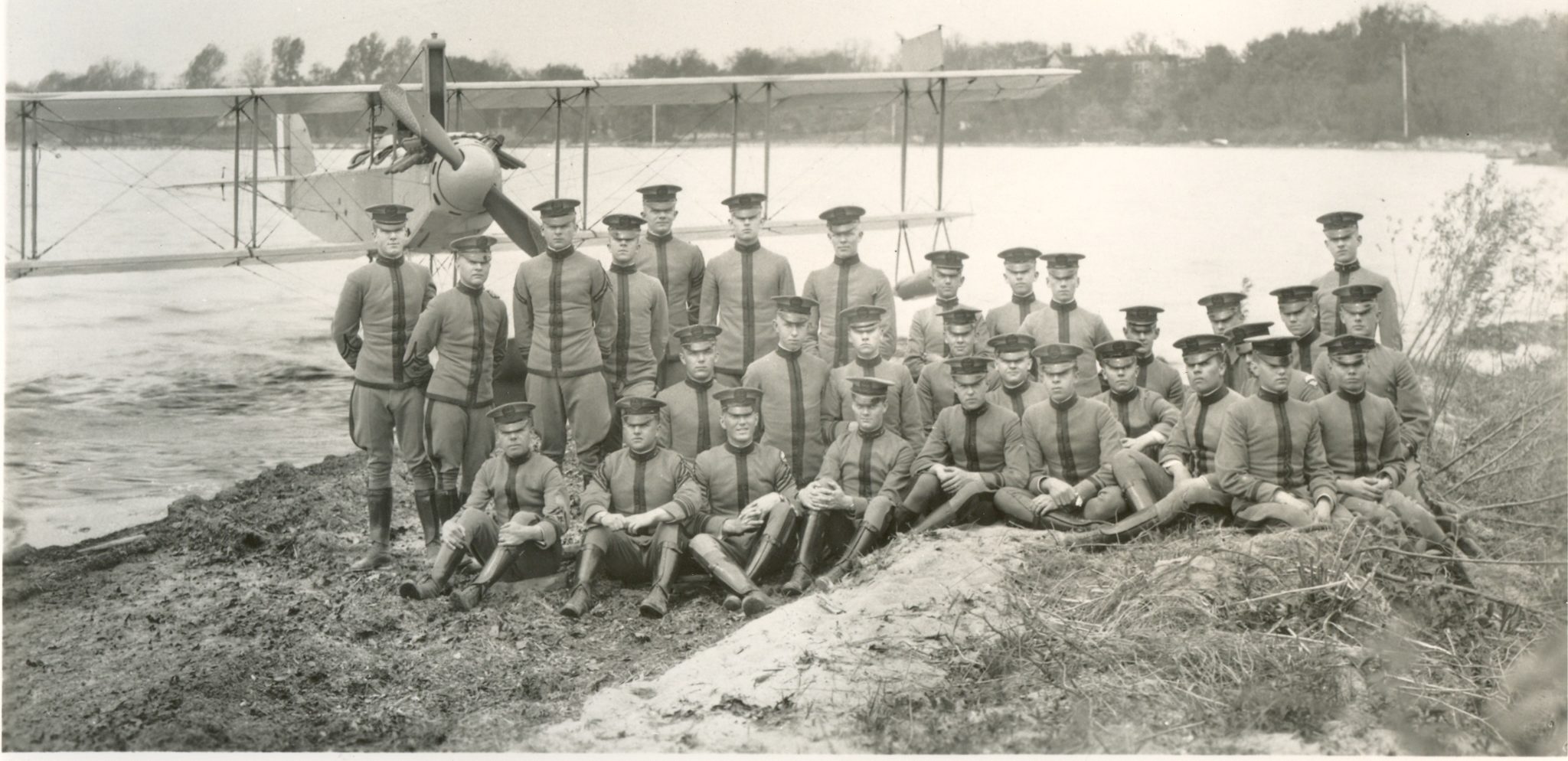The Lakes Area Has a Rich Aviation History
Writer / Jeff Kenney
Photography Provided
Lakes-area communities nowadays can each boast a small airport of their own, but it wasn’t always so, and one particular community has a unique and remarkable aviation legacy interwoven with its history.
While the Wright brothers’ storied first airplane flight took place in 1903, it took some years before aviation became a more commonplace endeavor. During some of those early years, communities around Marshall, Fulton, Starke and Pulaski counties thrilled to sporadic visits from single-engine planes to their areas, offering brief flights from farmers’ fields to the delight of crowds of spectators and passengers.
Aviation Pioneers
 World War I brought aviation into the forefront as a combat option, and when Culver Military Academy (CMA) superintendent, Colonel Leigh Gignilliat, returned from service in that war in 1919, he was contemplating tales of thrilling air battles and daring pilots. One of these pilots, in fact, was a 1913 graduate who had participated in the renowned rescue efforts of some 1,500 victims of the great flood of that year in nearby Logansport. Elliot White Springs would go on to found the famous Springmaid mattress and sheet company, but earned commendations as a fighter pilot in World War I. His recollections of air battles became a best-selling book, “War Birds: Diary of an Unknown Aviator.”
World War I brought aviation into the forefront as a combat option, and when Culver Military Academy (CMA) superintendent, Colonel Leigh Gignilliat, returned from service in that war in 1919, he was contemplating tales of thrilling air battles and daring pilots. One of these pilots, in fact, was a 1913 graduate who had participated in the renowned rescue efforts of some 1,500 victims of the great flood of that year in nearby Logansport. Elliot White Springs would go on to found the famous Springmaid mattress and sheet company, but earned commendations as a fighter pilot in World War I. His recollections of air battles became a best-selling book, “War Birds: Diary of an Unknown Aviator.”
In the meantime, 1906 Culver graduate Reuben Fleet had flown the first airmail flight in the world in 1918. Five years later, Fleet (whose name adorns the school’s gymnasium today) would launch Consolidated Aircraft, from which he designed and produced two of America’s best-known aircraft, the B-24 bomber and the PBY Catalina flying boat.
Another area connection relating to war was that of the Marmon family, still persisting in the same Lake Maxinkuckee cottage since the 1890s. Best known for building high-speed cars, including the Marmon Wasp, which won the first Indianapolis 500 race in 1911, the Marmon company also manufactured airplanes used during World War I. In fact, Ray Harroun, driver of that first Indy 500-winning car, landed a seaplane outside the Marmon cottage on Maxinkuckee a matter of weeks after the race was completed, just stopping in for a visit.
The Culver School of Aviation
In 1920, Colonel Gignilliat launched the Culver School of Aviation, initially with a small fleet of N9 naval floatplanes, stored in a hangar at the east end of the campus.
While the school’s initial foray into flight shut down in 1925, two of its graduates, Cass Hough, class of 1920, and Harry Sidle, class of 1922, went on become well-known in the aviation world. Hough played a leading role in the 8th Air Force technical section during World War II, and Sidle started his own airline.
 Eugene C. Eppley, Culver class of 1901, was an avid pilot and helped underwrite Omaha Municipal Airport (now known as Eppley Airfield). The Culver Academies auditorium today is named after him, after he funded its creation in 1959.
Eugene C. Eppley, Culver class of 1901, was an avid pilot and helped underwrite Omaha Municipal Airport (now known as Eppley Airfield). The Culver Academies auditorium today is named after him, after he funded its creation in 1959.
Among other Culver graduates notable in the world of aviation, 1936 alum Jay Zeamer was one of five CMA graduates to receive the Congressional Medal of Honor, in his case for heroic action while piloting a B-17 on an unescorted photo mission during World War II.
Pilot Ernest K. Gann, Culver class of 1930, wrote more than 20 novels, many of them dealing with flying. Some of his works, including “Fate is the Hunter,” “The High and the Mighty,” and “Island in the Sky,” were made into movies with major stars like John Wayne in starring roles. 1933 Culver Academy alum William J. Vanderkloot, Jr. flew Winston Churchill over enemy territory on diplomatic missions during World War II, and legendary World War II pilot Jimmy Doolittle’s son John P. Doolittle was a 1940 CMA grad and a Woodcraft summer camper in 1935.
CMA even had a line of small airplanes named after it. Knight K. Culver, descendant of Academies founder Henry Harrison Culver, launched his own aircraft company and, in 1939, released a highly regarded – and today highly collectible – small airplane called the Culver Cadet.
Genesis of Area Airports
The 1930s also saw the birth of most local airports, with area communities utilizing funds made available from the Civil Works Administration (CWA), one of the federal programs aimed at alleviating Great Depression-era poverty while improving communities and rural areas. In 1933, the town of Culver partnered with Culver Military Academy to apply for funding for an airport.
By the following year, it was announced that both Plymouth and Rochester had applied for funds for CWA airport projects, with Rochester purchasing land for their airfield in 1936.
In Culver’s case, the airport project shifted focus when the town fathers learned they could apply the funds to the town’s faltering sewer system, so the Academy took on the airfield as a private project near its golf course, east of campus. It became operational in 1940.
The first airport in Starke County developed somewhat earlier, in 1928, at the northeast corner of U.S. Highway 35 and State Road 8, north of Knox. It closed in the early 1930s as the Depression got underway, but the long-standing Starke County airport in Knox developed somewhat later, in 1944. A large portion of the 160-acre county farm was utilized, near the site of today’s Knox Community High School and shopping areas, though it was broken up and sold in 1971, and followed by the opening of the present-day Starke County Airport in 1977.
Culver’s Present-Day
Aviation School
In 1971 the more recent iteration of the Culver School of Aviation opened, centered at the new Fleet Field (also named for Reuben Fleet), located on Queen Road east of the Academy campus.
The following summer, Culver Academies added an aviation program to its summer-school offerings. While the high school and boarding school aviation program is no more, the Summer School of Aviation thrives as a crucial part of the school’s programming. Flight instruction has taken place at various airports in the Lakes Magazine readership area since the shutdown of Fleet Field in 2005.
Airborne Celebrities and More
In the meantime, the 1990s saw a unique aviation development in the form of Argos-based Buckeye Industries, which provided a powered parachute machine and lessons, courtesy of CEO Ralph Howard, for John F. Kennedy, Jr. and his wife. Around the same time, in 1999, nearby Rochester’s airport made waves when “Star Wars” and “Indiana Jones” star Harrison Ford flew his Bell helicopter in for a helicopter tour.
Winamac has been home for decades to an annual June gathering of aero modelers from all over the world at its “Jets Over the Heartland” event, a fun and fascinating showcase of model-sized aircraft crisscrossing the skies.
Two fine aircraft-related museums await Lakes-area readers just a short drive away, in the form of the Bell Aircraft Museum in Mentone, Indiana, and Grissom Air Museum in Peru, Indiana. There are a plethora of other area aviation stories, but it’s safe to say that the friendly skies of the Lakes area have been home to an array of notable aviation programs and people for more than a century.
* * *
Jeff Kenney is museum and archives manager for Culver Academies, and serves on the board of the Antiquarian and Historical Society of Culver.







Comments 1
I WORKED AT CMA FROM LATE 1956 UNTIL MID 2007. I’VE MET MANY OF THE AVIATION STUDENTS AND HAVE FLOWN WITH ONE OF THEM. I STRONGLY BELIEVE CMA SHOULD ENHANCE ITS AVIATION PROGRAM. CMA IS RTRULY A GREAT SCHOOL.